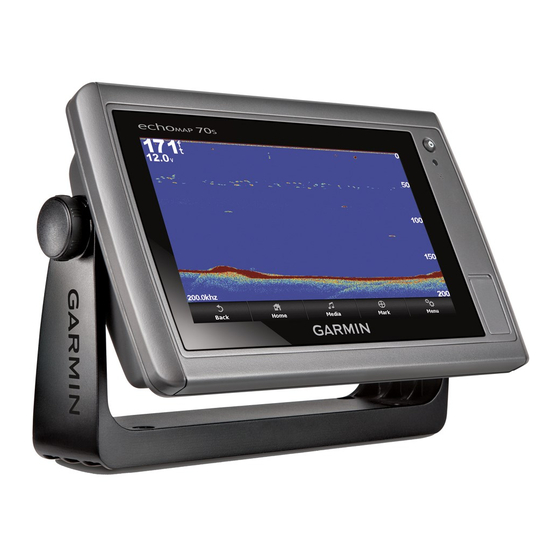5
Review the placement of the Auto Guidance line, and
determine whether the line safely avoids known obstacles
and the turns enable efficient travel.
6
Select an option:
• If the placement of the Auto Guidance line is satisfactory,
select MENU > Stop Navigation, and proceed to step 10.
• If the Auto Guidance line is too close to known obstacles,
select Settings > Navigation > Auto Guidance >
Shoreline Distance > Far.
• If the turns in the Auto Guidance line are too wide, select
Settings > Navigation > Auto Guidance > Shoreline
Distance > Near.
7
If you selected Near or Far in step 6, review the placement of
the Auto Guidance line, and determine whether the line
safely avoids known obstacles and the turns enable efficient
travel.
Auto Guidance maintains a wide clearance from obstacles in
open water, even if you set the Shoreline Distance setting to
Near or Nearest. As a result, the chartplotter may not
reposition the Auto Guidance line, unless the destination
selected requires navigation through a narrow waterway.
8
Select an option:
• If the placement of the Auto Guidance line is satisfactory,
select MENU > Stop Navigation, and proceed to step 10.
• If the Auto Guidance line is too close to known obstacles,
select Settings > Navigation > Auto Guidance >
Shoreline Distance > Farthest.
• If the turns in the Auto Guidance line are too wide, select
Settings > Navigation > Auto Guidance > Shoreline
Distance > Nearest.
9
If you selected Nearest or Farthest in step 8, review the
placement of the Auto Guidance line, and determine
whether the line safely avoids known obstacles and the turns
enable efficient travel.
Auto Guidance maintains a wide clearance from obstacles in
open water, even if you set the Shoreline Distance setting to
Near or Nearest. As a result, the chartplotter may not
reposition the Auto Guidance line, unless the destination
selected requires navigation through a narrow waterway.
10
Repeat steps 3 through 9 at least once more, using a
different destination each time, until you are familiar with the
functionality of the Shoreline Distance setting.
Auto Guidance Line Configurations
The Safe Depth and Safe Height settings influence how the
chartplotter calculates an Auto Guidance line. If an area has an
unknown water depth or an unknown obstacle height, the Auto
Guidance line is not calculated in that area. If an area at the
beginning or the end of an Auto Guidance line is shallower than
the safe water depth or lower than the safe obstacle height, the
Auto Guidance line is not calculated in that area. On the chart,
the course through those areas appears as a gray line. When
your boat enters one of those areas, a warning message
appears.
NOTE: Auto Guidance is available with premium charts, in some
areas.
You can set the parameters the chartplotter uses when
calculating an Auto Guidance line.
Safe Depth: Sets the minimum depth (chart depth datum) the
chartplotter uses when calculating an Auto Guidance line.
NOTE: The minimum safe depth for the premium charts is 3
feet. If you enter a Safe Depth value of less than 3 feet, the
charts only use depths of 3 feet for Auto Guidance route
calculations.
12
CAUTION
Safe Height: Sets the minimum height (chart height datum) of a
bridge that your boat can safely travel under.
Shoreline Distance: Sets how close to the shore you want the
Auto Guidance line to be placed. The Auto Guidance line
may move if you change this setting while navigating. The
available values for this setting are relative, not absolute. To
ensure that the Auto Guidance line is placed the appropriate
distance from shore, you can assess the placement of the
Auto Guidance line using one or more familiar destinations
that require navigation through a narrow waterway
the Distance from
Shore).
Combinations
The Combination screen shows a combination of different
screens at the same time. The number of options available on
the Combination screen depends on the optional devices you
have connected to your chartplotter and whether you are using
premium maps.
Selecting a Combination
1
Select Combinations.
2
Select a combination.
Customizing a Combination Screen
1
Select Combinations.
2
Use the arrow keys to highlight a Combination screen.
3
Select MENU > Configure Combination.
4
Select an option:
• To change the name, select Name, and enter a new
name.
• To change the arrangement of the information on the
screen, select Change Layout, and select a new layout.
• To change the information shown on the screen, select
Change Function, and select new information.
• To customize the data shown on the screen, select
Overlay Numbers
(Overlay Numbers
• To resize the information areas shown on the screen,
select Resize Combination.
Adding a Custom Combination Screen
You can create a custom combination screen to suit your needs.
1
Select Combinations > MENU > Add Combo.
2
Select an option:
• To change the name, select Name, enter a new name,
and select Done.
• To change the number of functions shown, select
Functions, and select a number.
• To change the function of the portion of the screen, select
the area to change, and select a function from the list on
the right.
• To change the vertical or horizontal split orientation of a
multi-function display, select Split, and select an option.
• To change how data appears on the page, select Overlay
Numbers, and select an option.
• To change the type of data shown, select Overlay
Numbers, select a data field, and select the new data
type.
When properly connected to a compatible transducer, your
chartplotter can be used as a fishfinder. Different sonar views
can help you view the fish in the area.
Settings).
Sonar
Combinations
(Adjusting

